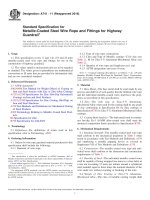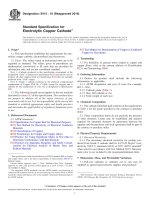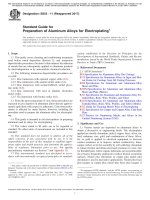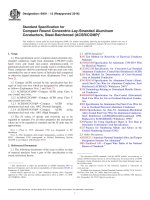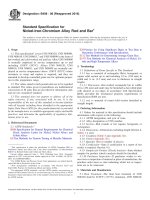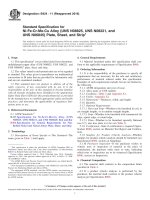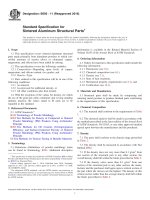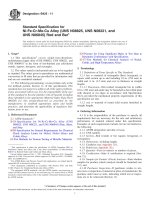Astm b 595 11 (2016)
Bạn đang xem bản rút gọn của tài liệu. Xem và tải ngay bản đầy đủ của tài liệu tại đây (77.46 KB, 3 trang )
Designation: B595 − 11 (Reapproved 2016)
Standard Specification for
Sintered Aluminum Structural Parts1
This standard is issued under the fixed designation B595; the number immediately following the designation indicates the year of
original adoption or, in the case of revision, the year of last revision. A number in parentheses indicates the year of last reapproval. A
superscript epsilon (´) indicates an editorial change since the last revision or reapproval.
information is available in the Related Material Section of
Volume 02.05 of the Annual Book of ASTM Standards.
1. Scope
1.1 This specification covers sintered aluminum structural
parts made primarily from aluminum powders to which controlled amounts of master alloys or elemental copper,
magnesium, and silicon have been added by mixing.
4. Ordering Information
4.1 Orders for material to this specification shall include the
following information:
4.1.1 Dimensions (see 9.1),
4.1.2 Chemical composition (see 6.1),
4.1.3 Density (see 7.1),
4.1.4 State of heat treatment,
4.1.5 Mechanical property requirements (see 8.1), and
4.1.6 Certification (see 14.1).
1.2 This specification covers the following variables:
1.2.1 Composition—Depending upon levels of copper,
magnesium, and silicon content, two grades, and
1.2.2 Density—Type.
1.3 Parts ordered to this specification will be in one of the
following conditions:
1.3.1 As-sintered,
1.3.2 As-repressed for additional density, or
1.3.3 All other conditions plus heat treated.
5. Materials and Manufacture
1.4 With the exception of the values for density, for which
the use of the gram per cubic centimeter unit is long-standing
industry practice, the values stated in SI units are to be
regarded as the standard.
5.1 Structural parts shall be made by compacting and
sintering metal powders to produce finished parts conforming
to the requirements of this specification.
2. Referenced Documents
6. Chemical Composition
6.1 The material shall conform to the requirements of Table
2
2.1 ASTM Standards:
B243 Terminology of Powder Metallurgy
B962 Test Methods for Density of Compacted or Sintered
Powder Metallurgy (PM) Products Using Archimedes’
Principle
B963 Test Methods for Oil Content, Oil-Impregnation
Efficiency, and Surface-Connected Porosity of Sintered
Powder Metallurgy (PM) Products Using Archimedes’
Principle
E8 Test Methods for Tension Testing of Metallic Materials
1.
6.2 The chemical analysis shall be made in accordance with
the methods prescribed in the latest edition of the Annual Book
of ASTM Standards, Vol 03.05, or any other approved method
agreed upon between the manufacturer and the purchaser.
7. Density
7.1 The parts shall conform to the density range prescribed
in Table 2.
3. Terminology
7.2 The density shall be measured in accordance with Test
Method B962.
3.1 Definitions—Definitions of powder metallurgy terms
can be found in Terminology B243. Additional descriptive
7.3 If the density does not vary more than 0.1 g/cm3 from
one section of the structural part to any other section, the
overall density shall fall within the limits prescribed in Table 2.
1
This specification is under the jurisdiction of ASTM Committee B09 on Metal
Powders and Metal Powder Productsand is the direct responsibility of Subcommittee B09.05 on Structural Parts.
Current edition approved June 1, 2016. Published June 2016. Originally
approved in 1973. Last previous edition approved in 2011 as B595 – 11. DOI:
10.1520/B0595-11R16.
2
For referenced ASTM standards, visit the ASTM website, www.astm.org, or
contact ASTM Customer Service at For Annual Book of ASTM
Standards volume information, refer to the standard’s Document Summary page on
the ASTM website.
7.4 If the density varies more than 0.1 g/cm3 from one
section of the structural part to any other section, the manufacturer and the purchaser shall agree upon a critical section of
the part where the stresses are the highest. The density of this
critical section rather than the average density shall fall within
the limits prescribed in Table 2.
Copyright © ASTM International, 100 Barr Harbor Drive, PO Box C700, West Conshohocken, PA 19428-2959. United States
1
B595 − 11 (2016)
TABLE 1 Chemical Requirements
Element
Copper
Magnesium
Silicon
Aluminum, min
Total of other elements,
determined by difference,
max
A
10.2 When parts are cut or fractured, the exposed surface
shall be of uniform appearance.
Composition, mass %
AXX-6061A
ACXX-2014A
0.5 max
0.4–1.2
0.2–0.8
96.0
1.5
3.5–5.0
0.2–0.8
1.2 max
91.5
1.5
11. Sampling
11.1 Chemical Analysis—If required by purchase
agreement, at least one sample for chemical analysis shall be
taken from each lot. A representative sample of chips may be
obtained by dry milling, drilling or crushing at least two pieces
with clean dry tools without lubrication. To obtain oil-free
chips, the parts selected for test shall have the oil extracted in
accordance with Test Method B963, if necessary.
“XX” denotes thermal condition – see footnote to Table X1.1
11.2 Mechanical Tests—The manufacturer and purchaser
shall agree on the number of specimens for mechanical tests.
TABLE 2 Density
3
Type
Dry Density, g/cm
I
II
III
2.30 to 2.45
2.45 to 2.60
2.60 min
12. Inspection
12.1 Unless otherwise specified, inspection of parts supplied on contract shall be made by the purchaser.
13. Rejection and Rehearing
8. Mechanical Properties
13.1 Parts that fail to conform to the requirements of this
specification may be rejected. Rejection should be reported to
the producer or supplier promptly and in writing. In case of
dissatisfaction with test results, the producer or supplier may
make claim for rehearing.
8.1 The manufacturer and the purchaser shall agree on
qualification tests for the determination of mechanical properties.
8.2 These tests shall be performed on production parts.
8.3 These tests shall be determined after consideration of
the function of the part.
14. Certification
14.1 When specified in the purchase order or contract, a
producer’s certification shall be furnished to the purchaser that
the parts were manufactured, sampled, tested, and inspected in
accordance with this specification and have been found to meet
the requirements. When specified in the purchase order or
contract, a report of the test results shall be furnished.
8.4 The limits and sampling plan shall be agreed upon
between the manufacturer and purchaser.
8.5 All shipments of parts subsequent to the establishment
of testing conditions shall conform to the limits agreed upon.
NOTE 1—The mechanical properties in tension and compression that
may be expected from standard specimens compacted to size are given in
Appendix X1 of this specification.
14.2 The purchase order shall specify whether or not the
certification includes chemical composition.
14.3 Upon request of the purchaser in the contract or order,
the certification of an independent third party indicating
conformance to the requirements of this specification may be
considered.
9. Dimensions and Tolerances
9.1 Permissible variations in dimensions shall be within the
limits specified on the drawings describing the structural parts
accompanying the order or shall be within the limits specified
in the order.
15. Keywords
15.1 as-repressed; as-sintered; density; interconnected porosity; oil-impregnated; powder metallurgy; sintered aluminum; structural parts; thermal condition
10. Workmanship, Finish, and Appearance
10.1 Structural parts shall be uniform in composition.
2
B595 − 11 (2016)
APPENDIX
(Nonmandatory Information)
X1. MECHANICAL PROPERTIES AND HARDNESS DATA
specimens cut from commercial parts. See Fig. 20 of Test
Methods E8.
X1.1 Data for the mechanical properties of sintered aluminum specimens are given in Table X1.1 The data do not
TABLE X1.1 Typical PropertiesA
A
B
Material Designation
CodeB
Type
AT1-6061
AT4-6061
AT6-6061
AT1-6061
AT4-6061
AT6-6061
ACT1-2014
ACT4-2014
ACT6-2014
ACT1-2014
ACT4-2014
ACT6-2014
ACT1-2014
ACT4-2014
ACT6-2014
I
I
I
II
II
II
I
I
I
II
II
II
III
III
III
Ultimate Tensile
Strength
Tensile Yield
Strength (0.2 % offset)
Elongation
in 25 mm
MPa
MPa
%
83
97
138
128
159
207
138
165
207
152
179
241
172
221
290
62
79
131
69
103
193
97
145
172
117
152
228
152
179
279
4.0
3.5
0.5
6.0
5.0
2.0
2.0
2.0
0.5
3.0
2.5
1.0
3.0
2.5
2.0
Apparent
Rockwell
Hardness
60–65
65–70
80–85
80–85
50–55
65–70
80–85
55–60
65–70
85–90
55–60
70–75
55–60
70–75
80–85
HRH
HRH
HRH
HRH
HRE
HRE
HRH
HRE
HRE
HRH
HRE
HRE
HRE
HRE
HRE
Typical sintering atmosphere for the above grades may be nitrogen, dissociated ammonia, or vacuum.
Description of Thermal Conditions:
T1 as-sintered.
T4 solution heat treated at 505 to 520°C, cold water quenched and aged minimum of 4 days at room temperature.
T6 solution heat treated at 505 to 520°C, cold water quenched and aged 18 h at 160 to 175°C.
constitute a part of this specification. They merely indicate to
the purchaser the mechanical properties that may be expected
from special tension specimens conforming to the density and
chemical requirements specified. It should be understood that
the values represent specimens compacted to size and not
X1.2 Hardness values are given as apparent values, as
described in General Description of Production, Properties, and
Uses of Metal Powder Sintered Bearings, and Sintered Metal
Powder Structural Parts (see gray pages).
ASTM International takes no position respecting the validity of any patent rights asserted in connection with any item mentioned
in this standard. Users of this standard are expressly advised that determination of the validity of any such patent rights, and the risk
of infringement of such rights, are entirely their own responsibility.
This standard is subject to revision at any time by the responsible technical committee and must be reviewed every five years and
if not revised, either reapproved or withdrawn. Your comments are invited either for revision of this standard or for additional standards
and should be addressed to ASTM International Headquarters. Your comments will receive careful consideration at a meeting of the
responsible technical committee, which you may attend. If you feel that your comments have not received a fair hearing you should
make your views known to the ASTM Committee on Standards, at the address shown below.
This standard is copyrighted by ASTM International, 100 Barr Harbor Drive, PO Box C700, West Conshohocken, PA 19428-2959,
United States. Individual reprints (single or multiple copies) of this standard may be obtained by contacting ASTM at the above
address or at 610-832-9585 (phone), 610-832-9555 (fax), or (e-mail); or through the ASTM website
(www.astm.org). Permission rights to photocopy the standard may also be secured from the Copyright Clearance Center, 222
Rosewood Drive, Danvers, MA 01923, Tel: (978) 646-2600; />
3
